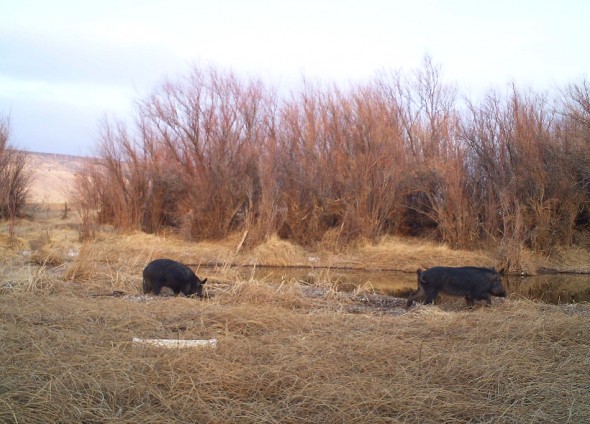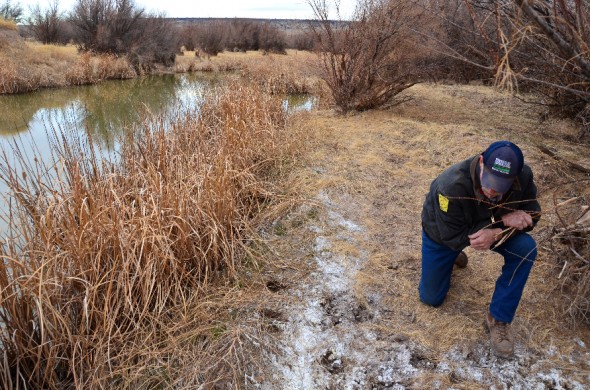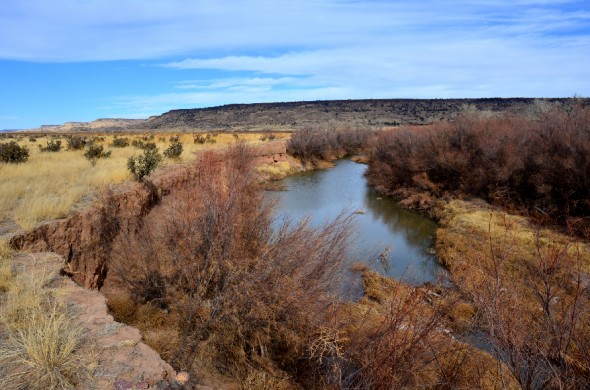It’s a cold February morning out on the windswept plains of New Mexico where Ron Jones, a Master Wildlife Specialist for the Wildlife Services Division of the United States Department of Agriculture’s (USDA) Animal, Plant, Health Inspection Service (APHIS) gets down from his pickup and scans the ground.
Within minutes Jones has located scat and tracks from wild hogs and begins to explain how they’ll be located and eliminated.
It’s a dirty little war that New Mexico appears to be winning with feral swine essentially eliminated in 10 out 17 infected counties in the state in 2013, federal authorities reports.
“The majority of pigs in those counties are largely gone now,” says Alan May, State Director of the Wildlife Services Division of the United States Department of Agriculture’s (USDA) Animal Plant Health Inspection Service (APHIS) in Albuquerque. “And we’re making good progress with the rest.”

Wild hogs on the Dry Cimarron caught on trail camera in February 2014 . In the foreground is a bait tube put out to attract the animals.
Federal hunters tracked down and eliminated about 700 wild pigs last year on about 5 million acres of land in 15 of 17 affected counties on mostly the state’s east side, according to May.
Most of those pigs caught were females which should seriously cut down on repopulation, May noted.

Ron Jones, Master Wildlife Specialist for the Wildlife Services Division of the United States Department of Agriculture’s (USDA) Animal, Plant, Health Inspection Service (APHIS) looks for evidence of wild hogs in the vast, remote riparian area of the Dry Cimarron River in northeastern New Mexico.
Two counties in the state’s boot heel are targeted next while efforts in the far northeast corner of the state are ongoing.
Domestic pigs turned wild are a highly destructive, invasive species that among other things compete with native wildlife for limited supplies of food and water.

Ron Jones, Master Wildlife Specialist for the Wildlife Services Division of the United States Department of Agriculture’s (USDA) Animal, Plant, Health Inspection Service (APHIS) finds tracks from wild hogs in the vast, remote riparian area of the Dry Cimarron River in northeastern New Mexico.
For example deer and bears rely heavily on acorns for food but wild hogs seek out and devour them too.
Wild pigs also prey heavily on birds and other small animals which has a negative impact on the natural food chain. They also can carry and spread diseases dangerous to wildlife.

Ron Jones, Master Wildlife Specialist for the Wildlife Services Division of the United States Department of Agriculture’s (USDA) Animal, Plant, Health Inspection Service (APHIS) inspects fresh droppings from wild hogs in the vast, remote riparian area of the Dry Cimarron River in northeastern New Mexico.
That’s why the state Department of Game and Fish (NMDGF) and other state, tribal and federal agencies as well as private groups and individuals have come together to work with Wildlife Services to attack the problem.
NMDGF has no jurisdiction over feral swine as they are considered domestic livestock gone wild – not wildlife.
And while wild hog hunting is a popular sport it is illegal in New Mexico to conduct commercial hunts for them or to import, hold, release or sell feral hogs.

Ron Jones, Master Wildlife Specialist for the Wildlife Services Division of the United States Department of Agriculture’s (USDA) Animal, Plant, Health Inspection Service (APHIS) prepares a captured”Judas Pig” which will be fitted with a Global Positioning System (GPS) radio collar so she can be released and tracked to the next group of wild hogs she may find find.
The pigs were first found in the state back in 2006 and since then their population has spread rapidly.
Last year the USDA earmarked $1 million to eliminate them here in New Mexico.
And the agency has seen good results despite some uncooperative private landowners hindering the effort.
“But we will continue to work with those few folks to explain the importance of what we’re trying to do so we can hopefully achieve statewide eradication someday,” May said.

The Dry Cimarron River spans thousands of acres in the northeast corner of the state where wild hogs have found an inviting home.
To read an in-depth report on the wild hog invasion see related article “Wild Hogs Invade New Mexico & Threaten to Wreak Havoc”.
For more information on dealing with wild hogs contact the Wildlife Services in Albuquerque at 505-346-2640 or go to their website at http://www.aphis.usda.gov and look under “Wildlife Damage.”
This article was originally published in the Spring 2014 edition of “New Mexico Wildlife”, an official publication of the New Mexico Department of Game and Fish and distributed statewide .


